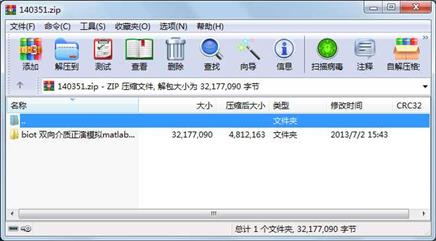资源简介
biot 双向介质正演模拟matlab程序

代码片段和文件信息
function [vp1freqvp2vsq1invq2invqsinv]=biot(vpdryvsdryk0mu0ro0roflkflnuporpermaalfad1d2opt)
%[VP1FREQVP2VSQ1INVQ2INVQSINV]
% =BIOT(VPDRYVSDRYK0MU0RO0ROFLKFLNUPORPERMAALFAD1D2‘PLOTOPT‘)
%
% calculates the complete Biot velocity dispersion and attenuation
% curves for all frequencies.
% Inputs: VPDRY: P-wave velocity of dry porous rock
% VSDRY: S-wave velocity of dry porous rock
% K0 MU0 RO0: Mineral Bulk modulus shear modulus and density
% ROFLKFLNU: Pore fluid density bulk modulus and viscosity
% POR PERM: Porosity and absolute permeability of porous rock
% A: pore size parameter; usually about 1/6-1/7 of grain diameter
% ALFA: Tortuosity parameter (always > 1) usually between 1-3
% D1D2: frequency range from 10^D1 to 10^D2
% ‘PLOTOPT‘: optional input for plotting. If nothing is given plots of
% all six outputs versus frequency are displayed. The following options
% selects only one of the outputs for plotting.
% ‘PLOTOPT‘=‘VP1‘ displays VP1 (fast P-wave) dispersion curve
% =‘VP2‘ displays VP2 (slow P-wave) dispersion curve
% =‘VS‘ displays VS (shear wave) dispersion curve
% =‘QP1‘ displays P1 attenuation curve
% =‘QP2‘ displays P2 attenuation curve
% =‘QS‘ displays S attenuation curve
% Outputs: VP1: Fast P-wave velocities at all frequencies
% FREQ: Frequencies at which velocity and attenuation are calculated
% VP2: Slow P-wave velocities at all frequencies
% VS: S-wave velocities
% Q1INV Q2INV QSINV: Fast and slow P-wave and S-wave attenuations
%
% See also BIOTHF BIOTHFB
% Written by T. Mukerji 1996
if nargin<15 % nargin 是matlab的内置函数,返回值为函数的输入参数的个数;
opt=‘all6‘;
end;
ro=(1-por)*ro0+por*rofl;%平均法计算饱和岩石的密度;
rodry=(1-por)*ro0; %计算干岩心的密度;
omc=por*nu/(rofl*perm);% 计算临界角频率;
mudry=rodry.*vsdry.^2; % 利用Vs_dry计算干岩心(骨架)的剪切模量;
kdry=rodry.*vpdry.^2-(4/3)*mudry; %利用Vp_dry计算干岩心(骨架)的体积模量;
d=k0*(1+por*(k0/kfl-1)); % 计算参数D,表达式见Handbook中P140;
h=kdry+(4/3)*mudry+(k0-kdry).^2./(d-kdry); % 计算参数H;
c=k0*(k0-kdry)./(d-kdry); %计算参数C;
m=k0.^2./(d-kdry); %计算参数M;
%从第47行到第58行都是为了计算q;
freq=logspace(d1d2100); % 在[0^d1,10^d2]之间等对数间距的产生100个数据点,返回值为行向量,1*100;
om=2*pi*freq; %计算角频率om为行向量,长度为100;
zeta=sqrt((rofl*a^2/nu)*om);%计算中间参数Zeta,为行向量,1*100;
t=zeros(size(zeta)); %设置零矩阵,1*100;
idx=[zeta <= 1e3];% idx与Zeta具有相同的长度,如果Zeta(j)<=1e3则idx(j)=1;反之,idx(k)=0;
idxl=[zeta <= 1e-1];
t(idx)=exp(i*3*pi/4)*bessel(1exp(-i*pi/4)*zeta(idx))./...
bessel(0exp(-i*pi/4)*zeta(idx));
t(~idx)=((1+i)/sqrt(2))*ones(sum(~idx)1);
f=0.25*zeta.*t./(1+i*2*t./zeta); % 计算参数F(Zeta)
f(idxl)=ones(sum(idxl)1);
qf=alfa*rofl/por - (i*nu/perm)*f./om;% 计算参数q;
%%%%%%%%%%%%test of qf
%qf=alfa*rofl/por + (i*nu/perm)*f./om; this equation is wrong; sign is -
%%%%%%%%%%%
b0=rofl^2-ro*qf;
b1=h*qf+m*ro-2*c*rofl;
b2=c^2-m*h; %b0b1b2为求解Vp时用的参数;
sl1sqr=(-b1+sqrt(b1.^2-4*b2*b0))./(2*b2);
sl2sqr=(-b1-sqrt(b1.^2-4*b2*b0))./(2*b2);
slssqr=(ro*qf-rofl^2)./(mudry*qf);
vp1=1./real(sqrt(s属性 大小 日期 时间 名称
----------- --------- ---------- ----- ----
目录 0 2013-07-02 15:43 biot 双向介质正演模拟matlab程序\
文件 2221462 2013-04-23 18:01 biot 双向介质正演模拟matlab程序\250ms_snapshotz_f.dat
文件 2220020 2013-04-23 18:01 biot 双向介质正演模拟matlab程序\250ms_snapshotz_s.dat
文件 4104 2011-09-29 17:15 biot 双向介质正演模拟matlab程序\biot.m
文件 10278 2011-12-22 16:01 biot 双向介质正演模拟matlab程序\biot_2_4_PML.m
文件 13860613 2013-04-23 18:01 biot 双向介质正演模拟matlab程序\offset_vx_s
文件 13860613 2013-04-23 18:02 biot 双向介质正演模拟matlab程序\offset_vz_s
 川公网安备 51152502000135号
川公网安备 51152502000135号
评论
共有 条评论